Search
Process of knife making
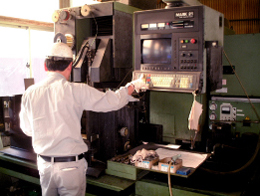 I explain the process for formings of the braids of the main parts.
I explain the process for formings of the braids of the main parts.
We make the plan from the hand design drawing by CAD, and convert it into the NC data by CAM, we do the machining by the machining centre.
The blade that ended heat-treatment corrects the distortion. It enters the grinding process by the hand work, it use the water sandpaper. We make the specular surface.( We change the sandpaper's grain degree like #400, #600,
#800, #1200, #2000.) This is a time-consuming process, because of the previous yarn number that returns and is ground again when there is a scratch. Afterwards, we finish it up by SMAP, and the specular is completed through a buff process.
The tip of the blade uses and finishes up by the Superfinisher of our originality development.
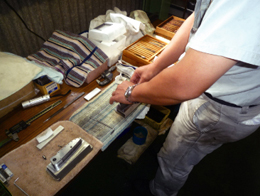
Blade shape
For years we have made knives with the "KATAKIRIBA" and "HONZUKURI" blade shapes, which are based on the traditional Japanese sword.
As a result, we applied the function of the time-honored Japanese sword to the knife, producing a knife which cuts well and has a strong blade design. With the KATAKIRIBA, the one side of the blade surface is convex and the opposing surface is a plane, while both sides of the HONZUKURI blade are the convex.
These cutting edge shapes function wonderfully. However, production is time-consuming so the process is quite expensive. Upon further researching of the blade, we ascertained that the angle in a small area in the tip of the blade influences sharpness.
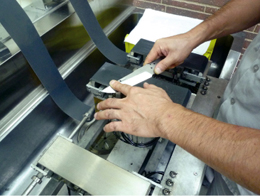 So we developed a special grinding jig device, giving birth to the SINOGIZUKURI, where both sides of the blade are planes. (SHINOGI being the ridge between the blade and blade edge.) For this manufacturing process we developed a new, advanced technology.
So we developed a special grinding jig device, giving birth to the SINOGIZUKURI, where both sides of the blade are planes. (SHINOGI being the ridge between the blade and blade edge.) For this manufacturing process we developed a new, advanced technology.
As a result of this, we realized the best edge angle near the haft of the blade is 30 degrees and in the point of the blade 24 degrees.(We adjusted the angle to 30 degrees in the haft side because power was most concentrated there, which improved toughness, and 24 degrees at the tip of the blade, where power was low. The angle changes continuously.)
We were able to realize a blade that suits the human anatomy by this technology, resulting in its wide popularity.
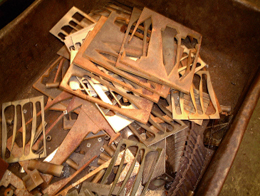
Mirror surface processing
When looking at usual knife edge through a microscope, it looks serrated like the blade of a saw. We ascertained one of the causes of a nick was the tip of these inadvertent protrusions, and we came to understand that the edge of the blade has to have a perfect mirror surface. You can confirm the different feel from a usual knife when you touch a ROCKSTEAD knife edge. Slicing a sheet of paper will confirm its unrivaled sharpness.
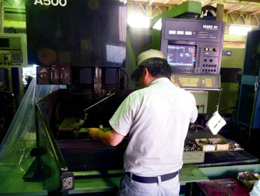
Steel material
The steel materials that we are currently using are carbon steel YXR7 and stainless steel ZDP189. Both of these are cutlery steel materials made by Hitachi Metals Ltd.
YXR7 (matrix high speed tool steel) A high-level steel material with wonderful properties, with a hardness of around HRc65 and very tough. These factors prevent blade nicks even after cutting and striking dried bamboo.
However, because it is carbon steel it can rust, but this one drawback can be overcome by the ROCKSTEAD KNIFE mirror finish. Still we will recommend the blade be wiped with cloth after use. Although we coat with DLC to prevent rust, DLC can be worn off with use in the tip of the blade. So we wiping as mentioned above.
ZDP189(powder stainless)A high carbon stainless steel specially produced for cutlery. The excellent hardness of HRc67 is made possible by introducing more carbon than can be contained in dissolution steel.
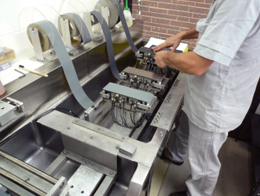 It is a steel material that reaches the epitome of nanotech technology. We are using clad steel of ZDP189 sandwiched by ATS34, or ZDP189 alone.
It is a steel material that reaches the epitome of nanotech technology. We are using clad steel of ZDP189 sandwiched by ATS34, or ZDP189 alone.
CAUTION : Please do not cut food on the plate with this knife. Hardness is high so this knife cuts the plate. And, simultaneously this knife-edge receive damage. You cannot cut the ceramic or iron with this knife. HAP72(Steel material of phantom) We are researching a steel material that is stronger than YXR7. And, the hardness of this steel is HRc70.
The prototype was completed. However and the price are considerably high so we postpone the selling. The steel better than this is not, and will be able to be called a steel material that collects the chic of the nanotech technology in the cutting steel of high hardness and high toughness now.
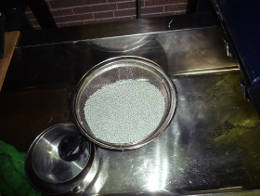
Function
We are demonstrating the ROCKSTEAD knife in knife shows all over the world. After cutting φ25mm Manila rope (hemp) 1000 times, you can slice paper with this ZDP189 blade, made possible due its high hardness of HRc67.
After cutting and striking dried bamboo about 500 times, you can slice paper with the YXR7 blade. The USA magazine Tactical Knife set up an experiment and continuously cut cardboard for three months with our knife (Beetle DLC) and reported that the sharpness had not deteriorated.
Re-grinding
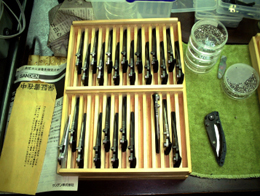
ROCKSTEAD knife recommends performing touch-ups rather than re-grinding.
An easy method is to wrap denim firmly around a handy board, and apply liquid metal polish to it, allowing it to dry.
Sharpness can be recovered by this process after 2-3 years of normal use.
Of course, the diamond paste can also be used.
Thank you to return your knife so the blade is worn and re-sharpening is necessary.
Of course, you can re-sharpen it yourself, however, it requires a certain level of skill.
Contact us, we will make a quotation upon receipt of the knife with shipping at your expense.